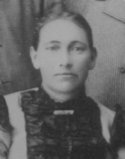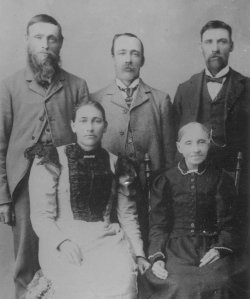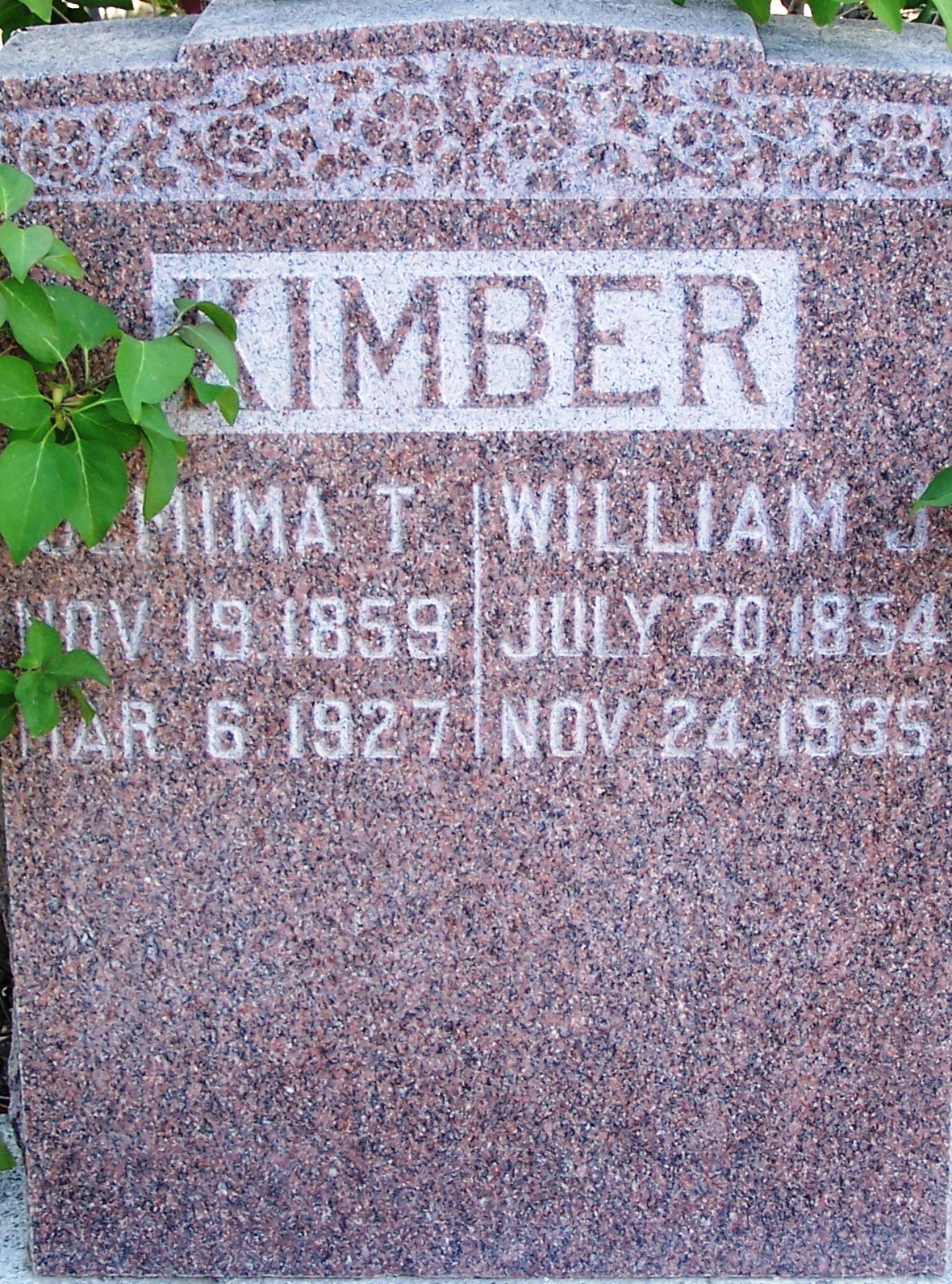 Jemima was affectionately known by many as “Aunt Minie,” and referred to with love and respect as “Mother” by her own family, but to me, she was “My Grandma Kimber.”
Jemima was affectionately known by many as “Aunt Minie,” and referred to with love and respect as “Mother” by her own family, but to me, she was “My Grandma Kimber.”
She was christened Jemima Mumford Tanner, (Mumford being in honor of her father’s mother’s maiden name.) She must have been welcomed and appreciated from the moment she arrived in her father’s household, where there were only sons, eight at the time, with the ninth boy born when she was still small. Although born into a home of humble circumstances, this home was blessed with a wholesome, religious influence, which was a sustaining factor throughout her life.
Jemima was born on November 19, 1859 in Tooele, Utah, a daughter of Thomas Tanner Sr. and Ann Newman Tanner. Utah at this time was still U. S. Territory, and Tooele a young community, having been settled only four years prior to the time her parents arrived to make their home. It is thought that she was born in the log home built by the Tanner family shortly after they came to the valley. This log home had a large living room with home-woven carpet. It was always a well kept and comfortable home. A large, two-story home was built shortly afterward on the same lot. Her father took pride in his orchard of fruit-trees, including plums, chokecherries, several varieties of apples, and some berries. There was also a large vegetable garden plot.

Moroni, Allen, Valison Sr, Ann, & Jemima Tanner
Jemima mastered the homemaking arts and worked hard as a girl and young woman to help sustain her family at home, and later to raise an honorable family of her own. They knew well the hardships and heartaches common to early pioneer life. However, this family learned to have “fun” together. Jemima’s niece, (her half-brother Joseph’s daughter), Maude Somsen, remembered how Minie loved to dance. As a girl in her teens she danced the “Varsouvienne,” “Schottische,” etc., so well with her brother Allen, as other brothers played. They had their own orchestra – one played the Jew’s harp, Joseph the accordion, Rone, the violin, and others harmonicas. Their father, also, was musically inclined, and led the choir. They often had candy-pulling and played checkers and cards.
Maude Somsen, her niece, described Jemima as “good-looking, rather tall, with beautiful brown hair and an enviable complexion.” She was a grown girl when Maude remembers coming to the home to visit and also remembered Jemima helping at the home in Clover (south of Tooele) when Maude’s younger brothers and sisters were born. Apparently Jemima helped other families too, as in the 1880 Federal Census ofTooele, her occupation was listed as “caring for the sick.”
Jemima learned to sew, and made the dress she was wearing in the photo we have of her taken in her teens, fashioned of intricate gathers, pleats, and ruffles. After she had a family of her own, she had little time for sewing except for darning and patching. In her later years her sister-in-law, Aunt Lizzie Cook made dresses and aprons for her.
She became known as a good cook, with nine brothers, then six sons of her own. Her son, Thomas E., commented “It’s no wonder Mother was such a good cook – she had so much practice.” During her years at the Kimber Ranch, their home was a haven for many travelers. Thomas E. adds “Our blinds were never closed, and a light shining through our window attracted people to our door all times of the night.”
Jemima’s father, Thomas Tanner Sr., was an intellectual and deeply religious man. Industrious and thrifty, he managed to build a comfortable home and provide for his family and apparently deserved their pride and love. He was a shoemaker by trade, having learned this profession and that of tanning leather in his native country of England. He was proud of his ancestry, as well as his own family of thirteen, ten of whom grew to maturity. He realized the value of keeping family records and wrote some interesting and detailed accounts of his life. It has been said he wrote a history and gave to each of his living children, together with letters of admonition. (I have four of these accounts that he wrote). Thomas was born on June 28, 1807 at Newbury, Berkshire, England, a son of Thomas Tanner and Jemima Mumford, and was the first to embrace the gospel there. He then moved to Obangreen, Buckinghamshire and raised up a branch of the Church there. He immigrated to St. Louis in 1851 and to Tooele in 1853.
Jemima’s mother, Ann Newman, was born on December 26, 1821, in South Witham, Lincolnshire, England. Ann’s father, Allen Newman, was born on July 1, 1783 at South Witham, a son of Allen Newman and Dorothy Smith. He died there on November 12, 1847. Ann’s mother, Sarah Cooper, was born in South Witham, in 1790. She died on March 24, 1835 at South Witham. Ann was only fourteen at this time. Her mother was forty-five. Ann became a convert to the Mormon church in 1848, then two years later emigrated toAmerica. In St. Louis, Missouri she met Thomas Tanner, a widower with six sons, and married him there in 1852. After crossing the Plains in ox-team, they settled in Tooele, Utah.
Jemima was baptized a member of the LDS Church on April 18, 1868 by Thomas Lee Sr., and confirmed the following day by Philip DeLaMare. At the age of fifteen she was given a Patriarchal Blessing by W. G. Young.
Her father died on July 28, 1879, when Jemima was twenty years old, and is buried in Tooele. About nine years later in June 1888, she and her mother, Ann and brother, Moroni, left Tooele and moved to Etna near Grouse Creek, Utah to join her other brothers who had settled there earlier.
The following summer, Jemima married William James Kimber, on July 4, 1889, by Justice of the Peace, Benjamin F. Cooke. She and her husband shared the log house at the Kimber Ranch with Williams’s parents’, Charles Kimber Sr. and Caroline (Sellwood) Kimber, and also her husband’s sister Lizzie Cook and her husband.
At this ranch, they became the parents of six sons and two daughters. The family did ranching, raised grain and other crops, built a reservoir, planted an orchard, as well as hauling ore, etc. improving the ranch as they could. A larger home was built in 1918.
In winter months, Jemima lived in Grouse Creek so the children could attend school, and her husband stayed on the ranch. Their eldest daughter, Bertha Caroline, died onMarch 17, 1900 during the scarlet fever epidemic, at the age of five years. Her son, Thomas E. was critically ill at the same time. She saw her two eldest sons go to war to fight for their country. Her oldest son, William, also served as an LDS Missionary. (Her son, Joseph was also serving a mission with his wife, Bertha Taylor, at the time of his death in New York State).
Jemima and her husband moved from the Kimber Ranch into their new log home in Grouse Creek in 1921. On November 16, that same year, she was endowed and sealed to her husband in the Salt Lake Temple.
Five and a half years later, she passed away after an illness on March 6, 1927, in Ogden, Weber County, Utah and was buried on March 9, 1927 in the Grouse Creek Cemetery beside her daughter Bertha Caroline. Her husband lived in the home another eight and one-half years, sharing it with their son, Joseph and family. Joseph’s wife, Bertha, said of Grandma Kimber, “She was a kind and generous person and loved by all.”
Written by Velma Kimber Jensen

